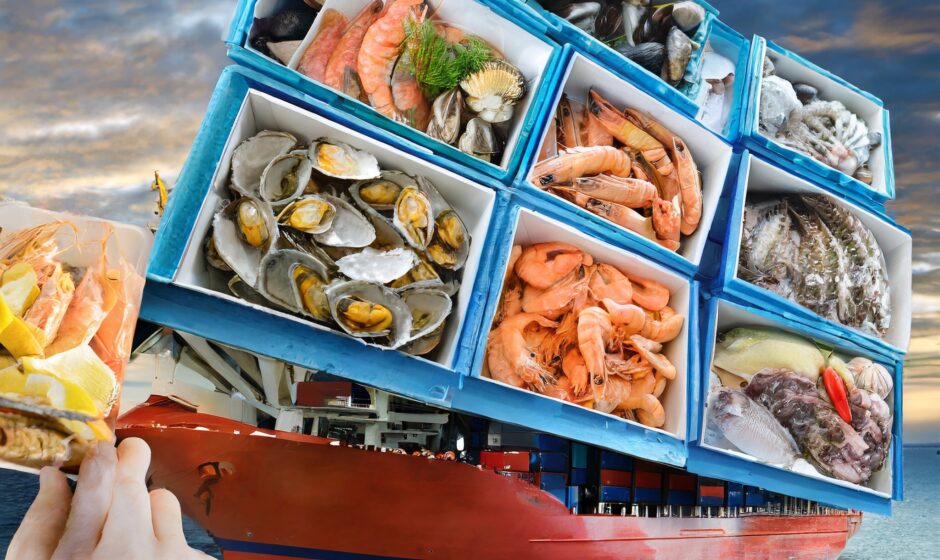India’s once-booming seafood export industry is currently weathering a storm. While the initial target for FY24 was a robust $9.25 billion, current estimates project a more modest figure of around $7.5 billion, falling short of the previous year’s $8.09 billion. This decline can be largely attributed to the sharp drop in global shrimp prices, particularly for vannamei shrimp, the kingpin of India’s seafood export basket.
A Perfect Storm for Shrimp Exporters:
The plummeting shrimp prices have had a ripple effect throughout the industry. Exporters faced significant financial constraints, struggling to maintain profitability as export values dipped. This, in turn, impacted aquaculture farmers who saw the bottom line of their operations shrink. The industry’s optimism for the year quickly faded, with hopes of reaching the ambitious target dashed by the second half of FY24.
Signs of a Turnaround: A Beacon on the Horizon?
However, amidst the current challenges, there are glimmers of hope suggesting a potential turnaround in the coming months. Here’s a deeper dive into the positive indicators:
- Price Stabilization and Increased Stocking: Shrimp prices are exhibiting signs of stabilization, providing a much-needed lifeline to the industry. This newfound stability has encouraged farmers to increase stocking in their farms for the upcoming summer crop. This proactive approach bodes well for a potential increase in export volumes in the next fiscal year.
- The US Market: A Glimmer of Light: The United States, a crucial market for Indian seafood, is expected to see a rise in shrimp demand as existing inventory dwindles. This presents a significant opportunity for Indian exporters to capitalize on and potentially bridge the export gap. Additionally, China’s post-spring festival trade activity will be closely monitored as it could influence overall market dynamics.
Beyond Price: A Strategic Advantage in Value-Added Products:
India holds a strategic advantage over some competitors like Ecuador when it comes to product offerings. While Ecuador primarily exports head-on, raw shrimp, India boasts a wider range of processed and value-added seafood products. This diversification offers greater resilience and the potential for higher profits in the global market.
Uncertain Currents: Challenges in Key Markets
Despite the positive indicators in the US market, the outlook for other major buyers like China and Europe remains somewhat murky. Economic slowdowns in these regions have led to reduced consumer spending, which could potentially dampen demand for imported seafood products.
Navigating Regulatory Headwinds:
Beyond market uncertainties, the industry faces additional challenges arising from recent government regulations. A new mandate requiring payments to domestic suppliers within 45 days could disrupt established payment cycles, particularly for exports to Europe, where payment cycles typically stretch over 90 days. Exporters are concerned about potential cash flow issues due to this regulation.
Shrimp Production: A Mixed Bag
While a slight increase in shrimp production is anticipated for the next harvest due to higher broodstock imports, overall production for 2023 is likely to fall short of 2022 figures. This highlights the need for continued efforts to optimize production efficiency and minimize the impact of external factors.
A Silver Lining: The Rise of Black Tiger Shrimp
Production of black tiger shrimp, a premium variety fetching higher prices, is expected to rise significantly. This positive development could potentially offset some of the decline in vannamei production and contribute to a more balanced export portfolio.
The Road Ahead: A Collaborative Effort for Sustainable Growth
The Indian seafood industry is undoubtedly navigating a challenging period. However, the presence of positive indicators, such as stabilizing shrimp prices, increased farm stocking, and a focus on value-added products, suggests a potential rebound in the coming months. To ensure sustainable growth in the long term, collaborative efforts are crucial. Government initiatives to streamline regulations, continued investment in farm technology, and a focus on market diversification will all be essential in helping the industry weather current storms and set sail for smoother sailing ahead.

